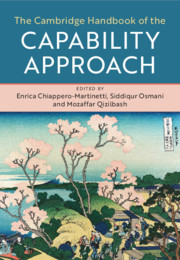Book contents
- The Cambridge Handbook of the Capability Approach
- The Cambridge Handbook of the Capability Approach
- Copyright page
- Dedication
- Contents
- Figures
- Tables
- Contributors
- Foreword
- Acknowledgements
- General Introduction
- Part I Historical Antecedents and Philosophical Debates
- Introduction to Part I
- 1 The Capabilities Approach and the History of Philosophy
- 2 Karl Marx and the Capabilities Approach
- 3 Utility and Capability
- 4 Intellectual History and Defending the Capabilities Approach
- 5 Sen, Smith and the Cambridge Tradition
- 6 The Capability Approach to Well-Being and Freedom from the Viewpoint of Welfare Economics and Social Choice Theory
- 7 Resources or Capabilities?
- 8 Taking Multidimensionality Seriously
- 9 The Capabilities Approach and Political Liberalism
- 10 Selecting a List
- 11 Individualism and the Capability Approach
- 12 The Politics of Wonder
- Part II Methods, Measurement and Empirical Evidence
- Part III Issues in Public Policy
- Index
- References
11 - Individualism and the Capability Approach
The Role of Collectivities in Expanding Human Capabilities
from Part I - Historical Antecedents and Philosophical Debates
Published online by Cambridge University Press: 11 November 2020
- The Cambridge Handbook of the Capability Approach
- The Cambridge Handbook of the Capability Approach
- Copyright page
- Dedication
- Contents
- Figures
- Tables
- Contributors
- Foreword
- Acknowledgements
- General Introduction
- Part I Historical Antecedents and Philosophical Debates
- Introduction to Part I
- 1 The Capabilities Approach and the History of Philosophy
- 2 Karl Marx and the Capabilities Approach
- 3 Utility and Capability
- 4 Intellectual History and Defending the Capabilities Approach
- 5 Sen, Smith and the Cambridge Tradition
- 6 The Capability Approach to Well-Being and Freedom from the Viewpoint of Welfare Economics and Social Choice Theory
- 7 Resources or Capabilities?
- 8 Taking Multidimensionality Seriously
- 9 The Capabilities Approach and Political Liberalism
- 10 Selecting a List
- 11 Individualism and the Capability Approach
- 12 The Politics of Wonder
- Part II Methods, Measurement and Empirical Evidence
- Part III Issues in Public Policy
- Index
- References
Summary
This chapter critically reviews the debate on individualism and the capability approach, arguing for the need to account for those capabilities that result from social interaction and collective action and are unachievable by single individuals. The first section explains how the capability approach adopts ethical individualism with its emphasis on the individual as the only unit of moral concern. Drawing on Sen’s and Nussbaum’s works, the second section explains how the approach accounts for the instrumental role of social structures in affecting individual freedoms, agency, identities and affiliations. The third section presents different concepts, such as irreducibly social goods, structures of living together, group capabilities and collective capabilities that aim to emphasize the intrinsic importance of collectivities and societal structures. The last section presents Sen’s responses to these critiques and highlights the need to account for a new type of capabilities that are generated at the collective level without necessarily sacrificing the primary focus on individual capabilities.
Keywords
- Type
- Chapter
- Information
- The Cambridge Handbook of the Capability Approach , pp. 206 - 226Publisher: Cambridge University PressPrint publication year: 2020

